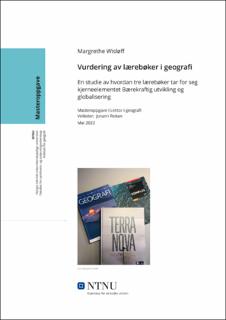| dc.description.abstract | I august 2020 tredde Kunnskapsløftet 2020 i kraft i den norske skolen. Dette er et nytt læreplanverk gjeldende for grunnskolen og videregående utdanning. Temaet bærekraftig utvikling har her fått en sentral plass både i overordna del og i mange av fagplanene. I fellesfaget geografi i den videregående skolen er «Bærekraftig utvikling og globalisering» formulert som et av fagets tre kjerneelementer. Tilknyttet Kunnskapsløftet 2020 er det gitt ut tre lærebøker for faget geografi. Dette er Terra Nova fra Aschehoug, Geografi fra Cappelen Damm og Kompass fra Gyldendal. Det overordna målet med denne studien er å vurdere hvordan disse tre lærebøkene behandler kjerneelementet «Bærekraftig utvikling og globalisering». For å svare på dette har jeg utarbeidet et analyseverktøy med utgangspunkt i kjerneelementet og gjennomført en horisontal lærebokanalyse av bøkenes behandling av temaet. For å støtte opp min tolkning av kjerneelementet og læreplanen har jeg gjennomført et intervju med lederen av læreplanutvalget i geografi.
Prosjektets funn viser at et fellestrekk ved Terra Nova og Geografi er at de i stor grad behandler temaet bærekraftig utvikling i tilknytning sine kapitler om bærekraft, klima og klimaendringer. Kompass på sin side behandler temaet mer gjennomgående i alle bokens kapitler. Alle de tre lærebøkene har størst fokus på kjerneelementets første del «vurdere bakgrunn for bærekraftig utvikling», noe som kan knyttes til den faktabaserte tradisjonen innenfor miljø og bærekraftsundervisning. Bøkenes behandling av konsekvenser av bærekraftig utvikling fokuserer i stor grad på konsekvensene av en utvikling som ikke er bærekraftig. I behandlingen av de tre aspektene ved bærekraftig utvikling fokuserer bøkene i størst grad på det miljømessige aspektet. Her skiller Kompass seg fra de to andre bøkene da den i større grad får frem de sosiale og økonomiske aspektene. Når det gjelder bøkenes behandling av «vurdere bærekraft på ulike geografiske nivå», kommer dette tydeligst frem gjennom bøkenes oppgaver om handlingsalternativer for å løse bærekraftsproblemer på lokalt nivå.
Alle de tre lærebøkene inneholder elementer fra både den faktabaserte, normative og pluralistiske tradisjonen innenfor miljø- og bærekraftsundervisning. Likevel er det Terra Nova som tydeligst kan knyttes til den faktabaserte tradisjonen, og Kompass som lettest kan knyttes til den pluralistiske tradisjonen. | |
| dc.description.abstract | In August 2020, the Kunnskapsløftet 2020 was established in Norwegian education. This is a new curriculum applicable to primary and secondary education. The theme of sustainable development is important both in the overall part and in many of the curricula. In the common subject of geography in upper secondary school, “Sustainable development and globalization” is formulated as one of three core elements. Associated with the Kunnskapsløftet 2020, three textbooks have been published for the subject geography. These are Terra Nova from Aschehoug, Geografi from Cappelen Damm and Kompass from Gyldendal. The overall goal of this study is to assess how these three textbooks address the core element of “Sustainable Development and Globalization”. To answer this, I have prepared an analysis tool based on the core element and performed a horizontal textbook analysis of the books’ treatment of the topic. To support my interpretation of the core element and the curriculum, I conducted an interview with the head of the curriculum committee in geography.
The project’s findings show that a common feature of Terra Nova and Geografi is that they largely address the topic of sustainable development in connection with their chapters on sustainability, climate and climate change. Kompass, on the other hand, deals with the topic more consistently in all chapters of the book. All three textbooks have the greatest focus on the core element’s first part «assess the background for sustainable development», which can be linked to the fact-based tradition within environment and sustainability education. The books’ treatment of the consequences of sustainable development focuses to a large extent on the consequences of a development that is not sustainable. In the treatment of the three aspects of sustainable development, the books focus to the greatest extent on the environmental aspect. Here, Kompass differs from the other two books as it brings out the social and economic aspects to a greater extent. When it comes to the books’ treatment of "assessing sustainability at different geographical levels", this is most evident through the books’ tasks on action alternatives for solving sustainability problems on a local level.
All three textbooks contain elements from both the fact-based, normative and pluralistic tradition within environmental and sustainability education. Nevertheless, it is Terra Nova that can most clearly be linked to the fact-based tradition, and Kompass that can most easily be linked to the pluralistic tradition. | |
